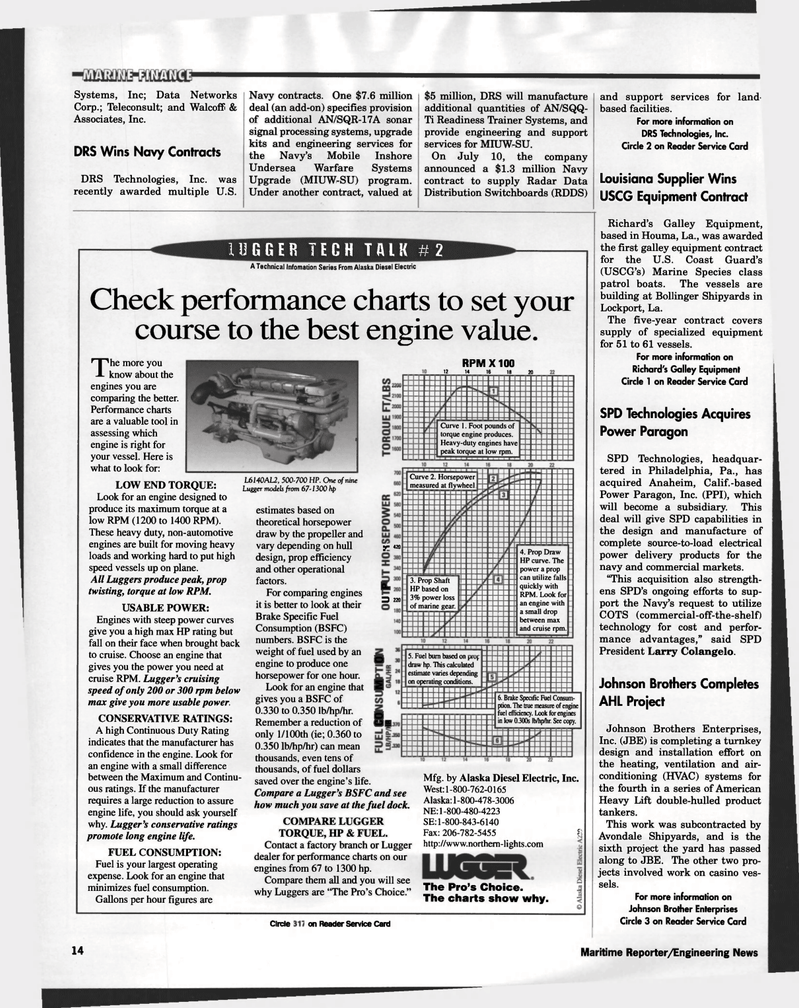
Page 14: of Maritime Reporter Magazine (August 1997)
Read this page in Pdf, Flash or Html5 edition of August 1997 Maritime Reporter Magazine
Systems, Inc; Data Networks
Corp.; Teleconsult; and Walcoff &
Associates, Inc.
DRS Wins Navy Contracts
DRS Technologies, Inc. was recently awarded multiple U.S.
Navy contracts. One $7.6 million deal (an add-on) specifies provision of additional AN/SQR-17A sonar signal processing systems, upgrade kits and engineering services for the Navy's Mobile Inshore
Undersea Warfare Systems
Upgrade (MIUW-SU) program.
Under another contract, valued at $5 million, DRS will manufacture additional quantities of AN/SQQ-
Ti Readiness Trainer Systems, and provide engineering and support services for MIUW-SU.
On July 10, the company announced a $1.3 million Navy contract to supply Radar Data
Distribution Switchboards (RDDS) and support services for land- based facilities.
For more information on
DRS Technologies, Inc.
Circle 2 on Reader Service Card
Louisiana Supplier Wins
USCG Equipment Contract
Richard's Galley Equipment, based in Houma, La., was awarded the first galley equipment contract for the U.S. Coast Guard's (USCG's) Marine Species class patrol boats. The vessels are building at Bollinger Shipyards in
Lockport, La.
The five-year contract covers supply of specialized equipment for 51 to 61 vessels.
For more information on
Richard's Galley Equipment
Circle 1 on Reader Service Card
SPD Technologies Acquires
Power Paragon
SPD Technologies, headquar- tered in Philadelphia, Pa., has acquired Anaheim, Calif.-based
Power Paragon, Inc. (PPI), which will become a subsidiary. This deal will give SPD capabilities in the design and manufacture of complete source-to-load electrical power delivery products for the navy and commercial markets. "This acquisition also strength- ens SPD's ongoing efforts to sup- port the Navy's request to utilize
COTS (commercial-off-the-shelf) technology for cost and perfor- mance advantages," said SPD
President Larry Colangelo. 11JGGE8 TEGH TALK # 2
A Technical Infomation Series From Alaska Diesel Electric
Check performance charts to set your course to the best engine value.
Johnson Brothers Completes
AHL Project
Johnson Brothers Enterprises,
Inc. (JBE) is completing a turnkey design and installation effort on the heating, ventilation and air- conditioning (HVAC) systems for the fourth in a series of American
Heavy Lift double-hulled product tankers.
This work was subcontracted by
Avondale Shipyards, and is the sixth project the yard has passed along to JBE. The other two pro- jects involved work on casino ves- sels.
For more information on
Johnson Brother Enterprises
Circle 3 on Reader Service Card 3. Prop Shaft
HP based on 3% power loss of marine gear. 5. Fuel bum based on prof draw hp. This calculated estimate varies depending on operating conditions.
Circle 205 on Reader Service Card
The more you know about the engines you are comparing the better.
Performance charts are a valuable tool in assessing which engine is right for your vessel. Here is what to look for:
LOW END TORQUE:
Look for an engine designed to produce its maximum torque at a low RPM (1200 to 1400 RPM).
These heavy duty, non-automotive engines are built for moving heavy loads and working hard to put high speed vessels up on plane.
All Luggers produce peak, prop twisting, torque at low RPM.
USABLE POWER:
Engines with steep power curves give you a high max HP rating but fall on their face when brought back to cruise. Choose an engine that gives you the power you need at cruise RPM. Lugger's cruising speed of only 200 or 300 rpm below max give you more usable power.
CONSERVATIVE RATINGS:
A high Continuous Duty Rating indicates that the manufacturer has confidence in the engine. Look for an engine with a small difference between the Maximum and Continu- ous ratings. If the manufacturer requires a large reduction to assure engine life, you should ask yourself why. Lugger's conservative ratings promote long engine life.
FUEL CONSUMPTION:
Fuel is your largest operating expense. Look for an engine that minimizes fuel consumption.
Gallons per hour figures are
RPM X 100 12 14 16 18 20
Curve 1. Foot pounds of torque engine produces.
Heavy-duty engines have peak torque at low rpm.
L6140AL2, 500-700 HP. One of nine
Lugger models from 67-1300 hp estimates based on theoretical horsepower draw by the propeller and vary depending on hull design, prop efficiency and other operational factors.
For comparing engines it is better to look at their
Brake Specific Fuel
Consumption (BSFC) numbers. BSFC is the weight of fuel used by an engine to produce one horsepower for one hour.
Look for an engine that gives you a BSFC of 0.330 to 0.350 lb/hp/hr.
Remember a reduction of only 1/100th (ie; 0.360 to 0.350 lb/hp/hr) can mean thousands, even tens of thousands, of fuel dollars saved over the engine's life.
Compare a Lugger's BSFC and see how much you save at the fuel dock.
COMPARE LUGGER
TORQUE, HP & FUEL.
Contact a factory branch or Lugger dealer for performance charts on our engines from 67 to 1300 hp.
Compare them all and you will see why Luggers are "The Pro's Choice."
Curve 2. Horsepower measured at flywheel jr 420 4. Prop Draw
HP curve. The power a prop can utilize falls quickly with
RPM. Look for an engine with a small drop between max and cruise rpm. 0- 3 220
O £ 6. Brake Specific Fuel Consum- ption. The true measure of engine fuel efficiency. Look for engines in low 0.300s lb/hp/hr. See copy. O O £
Mfg. by Alaska Diesel Electric, Inc.
West: 1-800-762-0165
Alaska: 1-800-478-3006
NE: 1-800-480-4223
SE: 1 -800-843-6140
Fax: 206-782-5455 ? http://www.northern-lights.com
The Pro's Choice.
The charts show why. 14 Maritime Reporter/Engineering News

 13
13

 15
15
